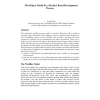Free Online Productivity Tools
i2Speak
i2Symbol
i2OCR
iTex2Img
iWeb2Print
iWeb2Shot
i2Type
iPdf2Split
iPdf2Merge
i2Bopomofo
i2Arabic
i2Style
i2Image
i2PDF
iLatex2Rtf
Sci2ools
ECOOPW
1997
Springer
1997
Springer
The Object Model for a Product Based Development Process
The traditional workflow process model is typically illustrated with a graph of activities, tasks, deliverables and techniques. From an object-oriented perspective, every identifiable concept can be depicted with an object, and from this same perspective, evolution can be demonstrated with object interactions. There are at least two ways to describe the software development process using an object-oriented model. The first, an activity-based approach, uses activities as objects, tasks as object operations and deliverables as operation postconditions. The second, a deliverablebased approach, uses deliverables as objects, tasks as object operations and activities as object states. Techniques are considered the implementation of operations in both cases. The article will: a) compare activity-based and deliverable-based object models of development processes and b) describe our experience with a deliverable-based object model that we used for about one year when we developed an applicatio...
Deliverable-based Object Model | Distributed And Parallel Computing | ECOOPW 1997 | Object Operations | Workflow Process Model |
| Added | 07 Aug 2010 |
| Updated | 07 Aug 2010 |
| Type | Conference |
| Year | 1997 |
| Where | ECOOPW |
| Authors | Pavel Hruby |
Comments (0)

